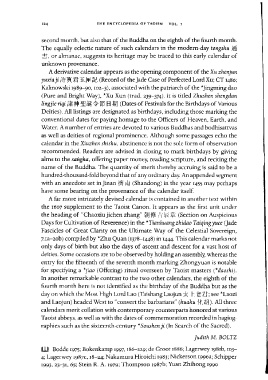Page 164 - The Encyclopedia of Taoism v1_A-L
P. 164
124 THE ENCYCLOPEDIA OF TAOISM VOL. I
second month, but also that of the Buddha on the eighth of the fourth month.
The equally eclectic nature of such calendars in the modern-day tongshu .®
~, or almanac, suggests its heritage may be traced to this early calendar of
unknown provenance.
A derivative calendar appears as the opening component of the XU zhenjun
yuxia ji ~f ~ tt ~ /l!! ~c (Record of the Jade Case of Perfected Lord Xu; CT 1480;
Kalinowski 1989-90, 102-3), associated with the patriarch of the *Jingming dao
(Pure and Bright Way), *Xu Xun (trad. 239-374). It is titled Zhushen shengdan
lingjie riqi i'itf f$ ~ ~ 4- ~j] B AA (Dates of Festivals for the Birthdays of Various
Deities). All listings are designated as birthdays, including those marking the
conventional dates for paying homage to the Officers of Heaven, Earth, and
Water. A number of entries are devoted to various Buddhas and bodhisattvas
as well as deities of regional prominence. Although some passages echo the
calendar in the Xiuzhen shishu, abstinence is not the sole form of observation
recommended. Readers are advised in closing to mark birthdays by giving
alms to the sangha, offering paper money, reading scripture, and reciting the
name of the Buddha. The quantity of merit thereby accruing is said to be a
hundred-thousand-fold beyond that of any ordinary day. An appended segment
with an anecdote set in Jinan i'J1f f~4 (Shandong) in the year 1455 may perhaps
have some bearing on the provenance of the calendar itself.
A far more intricately devised calendar is contained in another text within
the 1607 supplement to the Taoist Canon. It appears as the first unit under
the heading of "Chaoxiu jichen zhang" ~ f~ n ftZ ~ (Section on Auspicious
Days for Cultivation of Reverence) in the * Tianhuang zhidao Taiqing yuce (Jade
Fascicles of Great Clarity on the Ultimate Way of the Celestial Sovereign,
7.la-20b) compiled by *Zhu Quan (1378-1448) in 1444. This calendar marks not
only days of birth but also the days of ascent and descent for a vast host of
deities. Some occasions are to be observed by holding an assembly, whereas the
entry for the fifteenth of the seventh month marking Zhongyuan is notable
for specifYing a *jiao (Offering) ritual overseen by Taoist masters (*daoshi).
In another remarkable contrast to the two other calendars, the eighth of the
fourth month here is not identified as the birthday of the Buddha but as the
day on which the Most High Lord Lao (Taishang Laojun :;Is: J: 'it fl'; see *Laozi
and Laojun) headed West to "convert the barbarians" (huahu ft i5}j). All three
calendars merit collation with contemporary counterparts honored at various
Taoist abbeys, as well as with the dates of commemoration recorded in hagiog-
raphies such as the sixteenth-century *Soushenji (In Search of the Sacred).
Judith M. BOLTZ
m Bodde 1975; Bokenkamp 1997, 186-229; de Groot 1886; Lagerwey 1981b, 103-
4; Lagerwey 1987C, 18-24; Nakamura Hiroichi 1983; Nickerson 1996a; Schipper
1993, 23-31, 65; Stein R. A. 1979; Thompson 1987b; Yuan Zhihong 1990

